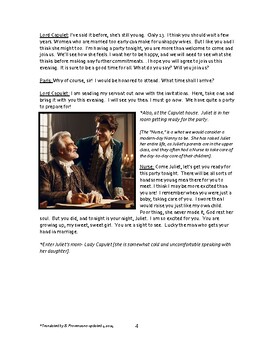


Do you think teenagers fall in love easily? Why or why not?.Have you ever had an experience like Romeo's or Juliet's?.Point out that Slide 8 poses the questions: "Why do we read Romeo and Juliet today?" and "How does the story connect to the lives of teenagers today?" Discuss these questions as a class, using the following prompts if needed:.You may wish to explain that audiences in the Shakespearean era typically came to plays already knowing the plot knowing the plot ahead of time is not a "spolier" as we consider it today.Pause frequently to check for understanding and to allow students to ask questions. View Part I of the PowerPoint: the summary of Romeo and Juliet.Read aloud the names of the characters, and have the students repeat the names to help them get used to reading and saying the names aloud.View the setting and list of characters on slides 2 and 3.Note that detailed information for the characters and plot summary slides are included in the notes section under each slide.

View and discuss the Tragic Love: An Introduction to Romeo and Juliet PowerPoint Presentation.Students should use the cloze notes handout to take notes during the presentation. Hand out the cloze notes for the Tragic Love: An Introduction to Romeo and Juliet PowerPoint Presentation and the Romeo and Juliet Major Character List.Explain that you will discuss the ideas from the questionnaire as you view a PowerPoint presentation about the play. Review the answers students gave for the questionnaire by having two or three students share their responses for each question.Pre-assess students' knowledge and opinions of Romeo and Juliet using the Assessment Questionnaire.Students participate as knowledgeable, reflective, creative, and critical members of a variety of literacy communities. Students whose first language is not English make use of their first language to develop competency in the English language arts and to develop understanding of content across the curriculum.ġ1. They draw on their prior experience, their interactions with other readers and writers, their knowledge of word meaning and of other texts, their word identification strategies, and their understanding of textual features (e.g., sound-letter correspondence, sentence structure, context, graphics).ġ0. Students apply a wide range of strategies to comprehend, interpret, evaluate, and appreciate texts. Students read a wide range of literature from many periods in many genres to build an understanding of the many dimensions (e.g., philosophical, ethical, aesthetic) of human experience.ģ. Among these texts are fiction and nonfiction, classic and contemporary works.Ģ. Students read a wide range of print and nonprint texts to build an understanding of texts, of themselves, and of the cultures of the United States and the world to acquire new information to respond to the needs and demands of society and the workplace and for personal fulfillment.


 0 kommentar(er)
0 kommentar(er)
